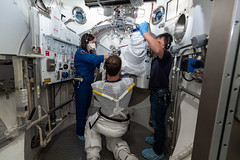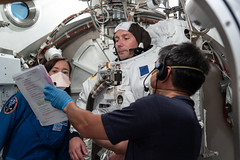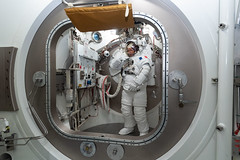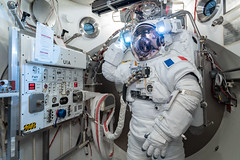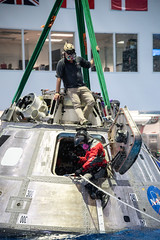Enter the spacesuit
samedi 10 octobre 2020 à 13:17Thomas Pesquet posted a photo:
Où trouver le vide le plus total sur terre, pour se préparer aux sorties en scaphandre ? Dans une chambre à vide bien sûr ! Après les préparatifs et les précautions nécessaires, la porte est refermée sur moi (version coffre-fort géant) et l'air est pompé hors de l'enceinte blindée (elle doit résister a la différence de pression). Il ne reste alors d'air et d'oxygène que dans mon scaphandre, comme dans l'espace ! Cet entraînement permet de se familiariser avec le matériel "de classe I" (le vrai matériel spatial), et de tester tous les systèmes en conditions réelles. Merci Aki et Megan de m'avoir aidé à enfiler le scaphandre... est-ce qu'il n'aurait pas rapetissé un peu depuis Proxima ?! ;)
After trying on the spacesuits, a next step is vacuum chamber testing to ensure there are no leaks. This kind of test is not without danger, as the air is pumped out of the chamber behind us and if the spacesuit were to fail... well reading about rapid depressurisation is not fun. It happened to a NASA engineer Jim Leblanc in 1965 and one of the last things he remembers is the saliva in his mouth boiling on his tongue :astonished:. Thankfully this is extremely rare and Jim survived without permanent damage. A salute to all the ground teams that prepare, train and make sure all spacewalks happen smoothly, thanks to the meticulous planning, engineering and training. Ready for the real thing!
SpaceX Crew-2 & Expedition 65 ESA astronaut Thomas Pesquet during EMU SSATA chamber run. Photo Date: September 22, 2020. Location: Bldg. 7, SSATA Chamber. Photographer: Robert Markowitz
jsc2020e041588
